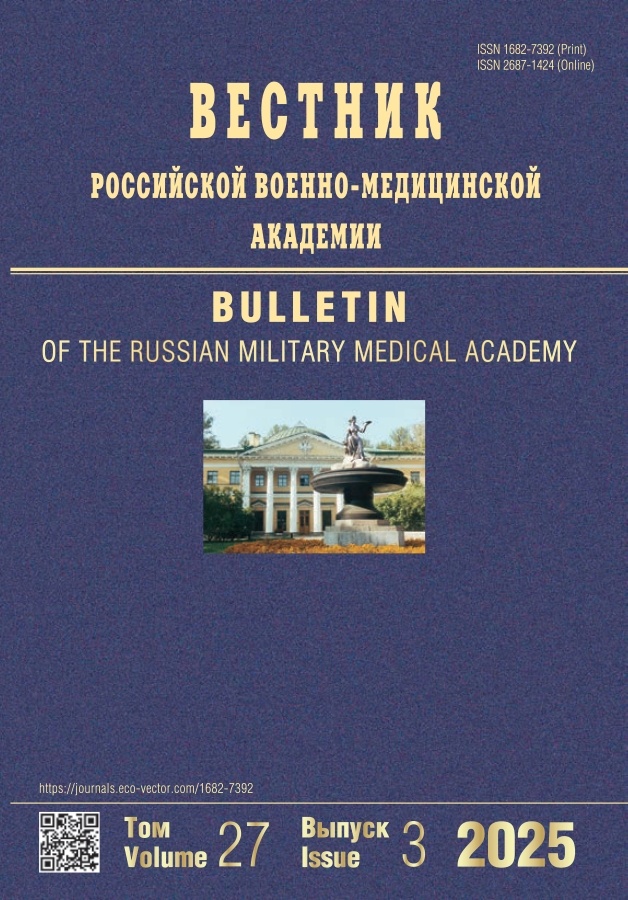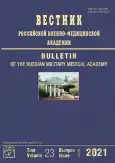Partial papillosphincterotomy with balloon dilatation in the treatment of choledocholytiasis in patients with parapapillary diverticulum
- 作者: Soloviev I.A.1, Musinov I.M.1, Koltsov V.A.2
-
隶属关系:
- Military Medical Academy named after S.M. Kirov
- Alexander Hospital
- 期: 卷 23, 编号 1 (2021)
- 页面: 15-22
- 栏目: Clinical trials
- URL: https://journals.rcsi.science/1682-7392/article/view/63563
- DOI: https://doi.org/10.17816/brmma63563
- ID: 63563
如何引用文章
详细
Results of treatment of 42 patients suffering from choledocholytiasis and parapapillary diverticle are compared, by which for treatment limited papillosfincterotomy supplemented with endoscopic balloon dilatation is performed with results of treatment of 56 patients with similar pathology, by which traditional endoscopic papillosfincterotomy was performed. Limited papillosphincterotomy with endoscopic balloon dilatation resulted in complete lithoextraction in 92.9% of cases as compared to 92.8% with endoscopic papillosphincterotomy only; an adequate drainage of extrahepatic bile ducts was achieved in 100% and 96.4%, respectively (p > 0.05). With endoscopic papillosphincterotomy, full removal of all concretions with a diameter of less than one centimeter was achieved without mechanical lithotripsy; for concretions from 1 to 1.5 cm in size the mechanical lithotripsy was necessary in 45.5% of cases. Limited papillosphincterotomy with endoscopic balloon dilatation allowed lithoextraction of concretions with a diameter of up to 1.5 cm without mechanical lithotripsy in all patients. The mechanical lithotripsy for concretions with a diameter above 1.5 cm was necessary in 60% of cases for both methods. In the treatment arm, two (4.8%) cases with complications were observed, while in the control arm there were 13 (23.2%) cases (p = 0.012). Acute pancreatitis was the only postoperative complication for which significant difference was observed (р = 0.043). In addition, after endoscopic papillosphincterotomy the incidence of bleeding from the suture line was 3.6% and the incidence of perforation of diverticula was 3.6%; this required an open surgery. The above mentioned demonstrates the advantages of limited papillosphincterotomy with endoscopic balloon dilatation over endoscopic papillosphincterotomy to resolve choledocholytiasis in the presence of parapapillary diverticulum.
作者简介
Ivan Soloviev
Military Medical Academy named after S.M. Kirov
编辑信件的主要联系方式.
Email: vmeda-nio@mil.ru
Doctor of medical sciences, professor
俄罗斯联邦, Saint PetersburgIgor Musinov
Military Medical Academy named after S.M. Kirov
Email: vmeda-nio@mil.ru
Doctor of medical sciences, associate professor
俄罗斯联邦, Saint PetersburgVladimir Koltsov
Alexander Hospital
Email: kolk13@yandex.ru
Endoscopist
俄罗斯联邦, Saint Petersburg参考
- Kotiv BN. Surgical treatment of non-neoplastic mechanical jaundice. Ukrainskii gurnal chirurgii 2013;22(3):50-57. (In. Russ).
- Testoni P. Papillary cannulation and sphincterotomy techniques at ERCP: European Society of Gastrointestinal Endoscopy (ESGE) Clinical Guideline. Endoscopy. 2016;48(7): 657–683.
- Gromova IV. Endoscopic diagnostic and therapeutic interventions in parapapillary diverticula. Annals surgical hepatology. 2000;5(1):109–113. (In Russ.)
- Budzinskii SA. Results of treatment of complications of endoscopic transpapillary interventions. Annals surgical hepatology. 2015;20(3):84–93. (In Russ.)
- Kotovsky AE. Diagnostic and therapeutic endoscopic interventions for parapapillary diverticula of the duodenum Annals surgical hepatology. 2009;14(1):68–74. (In Russ.)
- Alizadeh AH. ERCP Features and Outcome in Patients with Periampullary Duodenal Diverticulum. ISRN Gastroenterology. 2013;(10):1–5.
- Gabriel SA. Endoscopic retrograde interventions in the treatment of patients with diseases of the pancreato-biliary zone. Cubanskii nauchnyi medicinskii vestnik. 2013;(3):41–43. (In Russ.)
- Bykov MI. Possibilities of endoscopic transpapillary surgery of choledocholithiasis in diverticula of the papillary zone of the duodenum. Hirurgia. Gurnal im. N.I. Pirogova. 2015;(10):30–35. (In. Russ).]
- Agundez M. Lemmel’s Syndrome: Obstructive Jaundice Secondary to a Duodenal Diverticulum. J. Cir Esp. 2017;95(9): 550–551.
- Khrustaleva MV. Endoscopic transpapillary methods of treatment of choledocholithiasis. Annals surgical hepatology. 2015;20(4):74–80. (In Russ.)
- Karsenti D. Complete endoscopic sphincterotomy with vs. without large-balloon dilation for the removal of large bile duct stones: randomized multicenter study. Endoscopy. 2017;49(10):968–976.
- Salerno R. Endoscopic retrograde cholangiopancreatography, lights and shadows: Handle with care. World J. Gastrointest. Endosc. 2019;11(3): 219–230. doi: 10.4253/wjge.v11.i3.219
- Galperin EI. Classification of the obstructive jaundice severity. Annals surgical hepatology. 2012;17(2):26–33. (In Russ.)
- Boix J. Impact of periampullary duodenal diverticula at endoscopic retrograde cholangiopancreatography: a proposed classification of periampullary duodenal diverticula. Surg. Laparosc. Endosc. Percutan. Tech. 2006;16:208–211.
补充文件








